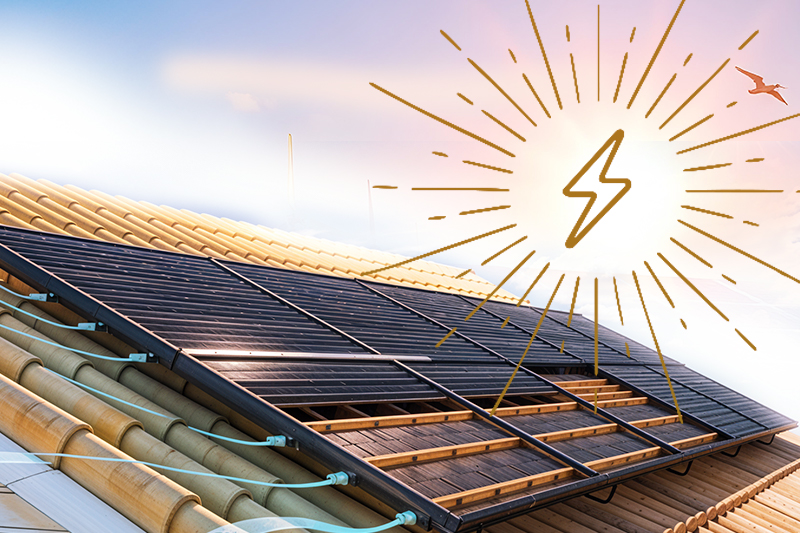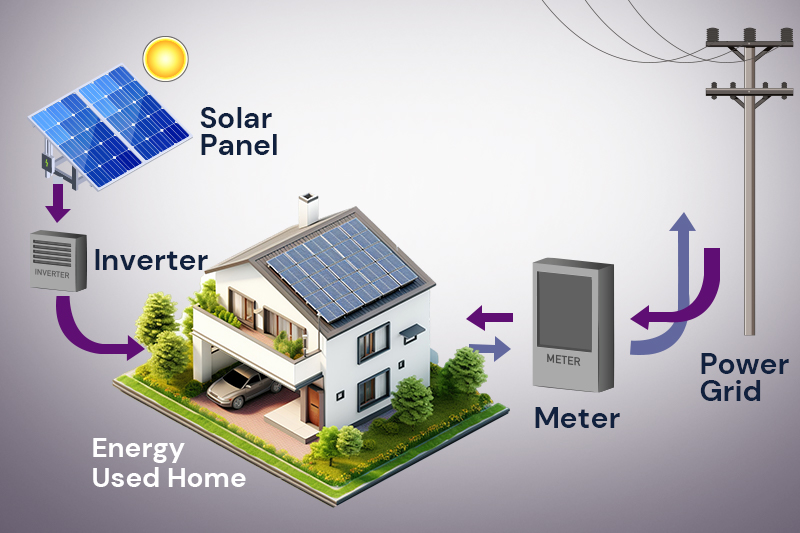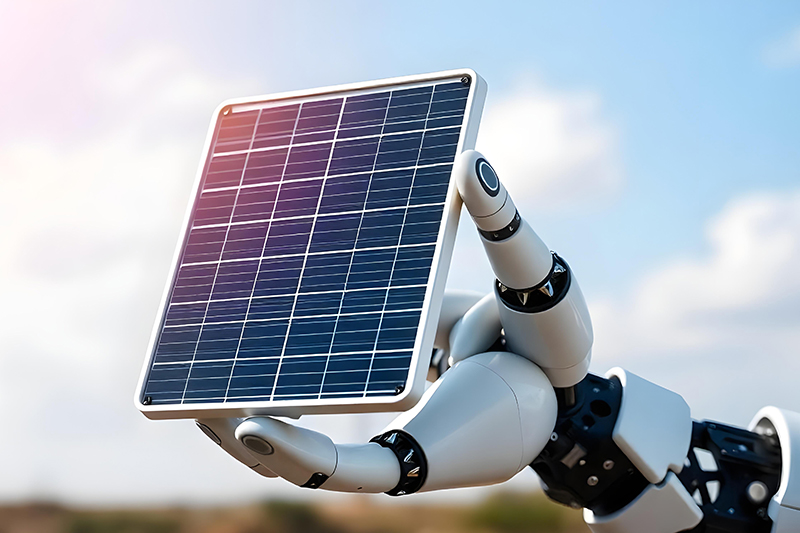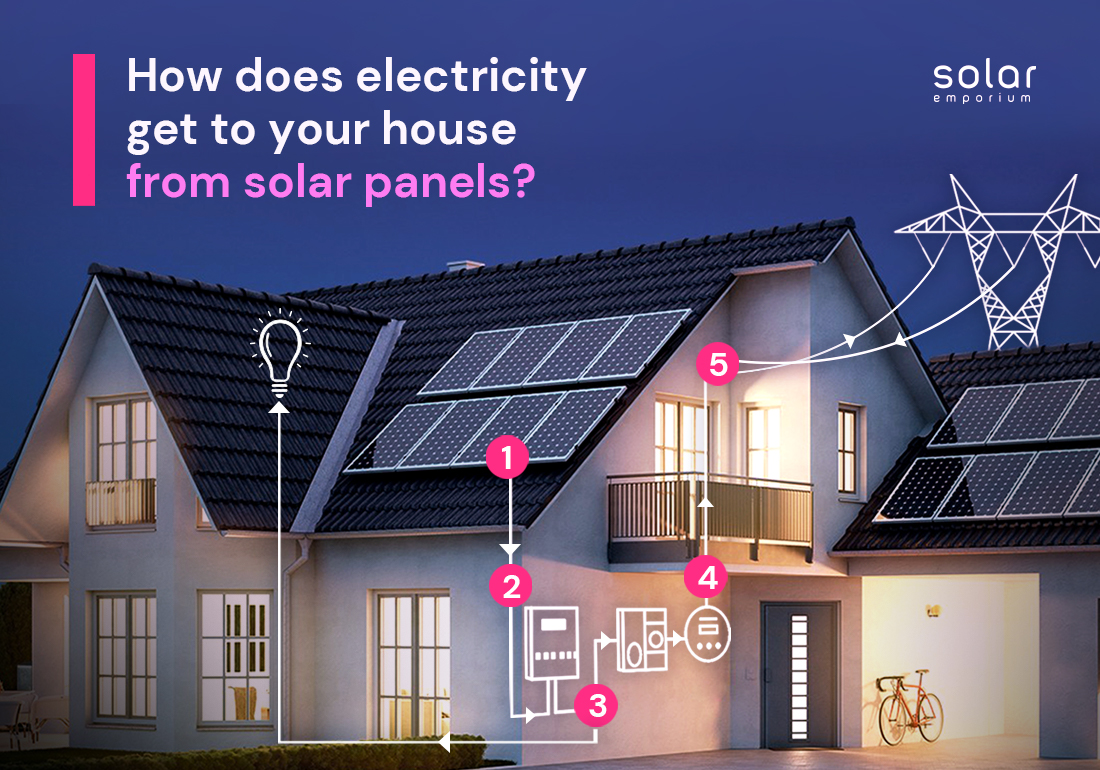In Australia, abundant sunshine is not just a pleasant weather condition for the people. Beyond sharing warmth and light, they believe the sun has the magical power to illuminate their homes and promote sustainable living.
Solar panels generate clean energy, which helps to reduce monthly energy bills. They also eliminate carbon footprints while contributing more to Australia’s sustainable future goals.
But what’s more? How does this power from your solar panel make its way to energize your house? We know these questions often come into your mind.
So, let’s dive into the solar world and explore the fascinating journey from capturing sunlight to powering your living space!
Understanding Solar Energy: How Sunlight Powers Our World
Solar energy is considered a reliable source to meet the world’s energy needs. With zero emissions, it has the potential to shape the future of renewable energy.
However, before discovering how electricity gets to your house from solar panels, let’s quickly glimpse at what solar energy is and the component requirements for efficient solar systems.
What is Solar Energy?
Simply put, Solar energy is a renewable energy source derived from sunlight. During peak times of the day, sunlight is captured using photovoltaic (PV) cells. The captured energy is then converted into electricity or heat to power electrical appliances.
In general, there are two main types of solar energy systems: photovoltaic (PV) systems and solar thermal systems.
Compared with fossil fuel, both systems have minimal to zero environmental impact and don’t deplete natural resources. Also, the self-renewal feature makes solar a leading player in sustainable energy solutions.
Does Solar Panel Integration Improve Your Home’s Electrical Performance?
Certainly! Integrating solar can enhance electrical performance and bring numerous benefits to your home, including energy independence and cost savings. It leads to better energy management and shields you from rising electricity prices.
Generating your own energy with your rooftop solar panel can also reduce your carbon footprint, increase property values and offer long-term energy savings for a modern eco-friendly lifestyle.
No matter what time of day it is or in which area you live, installing a solar panel system reduces dependency on the grid. This can be particularly beneficial during power outages or in areas with unreliable electricity supply.
So, overall, integrating solar significantly enhances your home’s resilience and manages your energy usage more effectively.

Unveiling How Solar Panels Actually Work to Supply Electricity in Australian Houses?
Solar energy has become increasingly popular as a clean, renewable power source for homes across Australia in 2024. As interest grows, more and more panels are installed in homes or rooftops nowadays.
Solar panels capture sunlight and convert the sun’s energy to DC electricity. An inverter then transforms this DC power into AC electricity to power the house.
However, before going into further details, let’s have an overview of solar panels and their types.
A solar panel is a device that converts sunlight directly into usable electricity. It consists of individual solar cells made from semiconductor materials, mostly silicon.
When sunlight hits these cells, it creates an electric field across the layers, generating electricity. The current is then stored in solar batteries or sent to the grid, which can be used later during unexpected power outages or when needed.
Solar installers commonly use two types of solar panels: Monocrystalline and Polycrystalline. However, there is also another one called Thin-Film Solar Panels.
Monocrystalline solar panels
- Typically, black or dark grey.
- Performs better in high temperatures and shaded conditions.
- Offers higher efficiency (typically 15-20%)
- Outstanding longevity.
- Requires less space due to compact size.
Polycrystalline solar panels
- Usually blue color with a speckled appearance.
- More affordable option.
- Slightly lower efficiency (typically 15-17%) in extreme temperatures.
- More accessible option.
Main Components of a Solar Panel System
In a solar panel system, several key components work collaboratively to capture sunlight and convert it into usable electricity.
So, here we have listed the main components required to make an efficient solar panel system.
Solar Panels: Capture sunlight and convert it into direct current (DC) electricity through the photovoltaic effect.
Solar Inverter: Solar Inverters are usually used for DC to AC conversion. This device converts the DC electricity generated by the solar panels into alternating current (AC) electricity before using it for household appliances.
Solar Battery Storage: Although installing batteries is optional, solar battery storage can store excess electricity generated by the solar panels. Batteries make the system more efficient and reliable when the sun isn’t shining, such as at night or during cloudy days.
Charge Controller: The charge controller manages the flow of electricity. It helps to prevent overcharging and extends the life of the batteries.
Electrical Panel: When connecting solar electricity with your home’s electrical system, an electrical panel, also known as a breaker box, is important. It includes circuit breakers to protect the system from any electrical faults.
Utility Meter: In grid-tied systems, adding a utility meter helps to track energy usage patterns. Through net metering, you can measure your solar system’s electricity and how much is consumed or fed back into the grid.
Monitoring System: Smart solar monitoring systems can track the performance of your solar panel and share data about system health. It helps to identify and address any issues beforehand with subjective data.

Plugging into the Sun: How Connecting Solar Panels to Your Home's Electrical System
Thinking of installing solar panels and wondering how electricity gets to your house from solar panels?
You’re not alone! As more homeowners switch to solar energy, getting the installation right is crucial. It’s not only for efficiency but also for your home’s safety.
So, what does it take to properly connect solar panels to your home’s electricity? Let’s break it down step by step.
The Solar Power Generation Process
Solar panels capture sunlight during peak daylight hours. When sunlight hits the panel, its semiconducting material creates an electric field that excites electrons. This process is known as the photovoltaic effect, which generates DC electricity.
So, place the panel in a well, sun-exposed area, such as roofs, windows or a parking area, for better efficiency and electricity production.
Then comes the role of solar inverters, which convert this stored energy from DC to AC. House appliances use alternating current (AC) electricity, so to make solar compatible with your home’s electric setup, don’t forget to add the best solar inverters in Australia.
From Solar Panels to Your Home
After DC to AC conversion from the inverter, the alternating current is sent to your home’s electrical panel. From there, it is distributed throughout the house’s electrical appliances.
However, if the solar panels generate more electricity than your home consumes, the excess energy is sent back to the grid (in grid-tied systems) or stored in a battery in systems with energy storage (in a battery storage system).
Solar panels generate electricity only during the day. So, to enjoy the full benefits of solar energy and ensure greater energy independence, you should add battery storage.
Now, let’s examine whether solar energy makes any difference in getting electricity for off-grid and on-grid systems.
Grid-Tied Systems: Interaction with the Power Grid
If you are connected to grid-tied solar systems, you are connected to the local electrical grid. In this system, you don’t need a battery and use the grid as a backup power source when the solar panels aren’t producing enough electricity.
Here, the excess energy is sent to the electricity grid, which, in return, offers credits on electric bills or payments through net metering or feed-in tariffs.
Australia has various feed-in tariff schemes and Renewable Energy Targets (RET) that provide compensation or credits for this extra energy. So, by exporting this power, you can earn money or reduce your electricity bill and enjoy more energy security.
However, remember that a grid-tied system doesn’t supply electricity during grid failure or power outages, so a battery is the ultimate solution when you want a reliable solution.
Off-Grid Systems: Stand-Alone with Battery Storage
Wondering how electricity gets to your house from solar panels if you live off-grid?
Don’t worry! A solar power system is entirely sufficient. Just adding a large battery, like 10kW, will be enough to keep you illuminated with a continuous power supply at night and on cloudy days with less sun exposure.
As these systems don’t need to be connected to the utility grid and store energy independently, they are ideal options for people living in remote areas or places without grid access.
Safety Measures and Maintenance Tips for Proper Solar Installation
Installing and maintaining solar panels involves a set of safety measures and routine maintenance to ensure optimal performance and longevity.
Here’s a comprehensive guideline to follow:
Safeguarding Your Solar Investment
The first and foremost thing to consider while installing solar panels is their structural integrity, such as your roof compatibility. Ensure you have the necessary permits to comply with local regulations and codes.
For this purpose, it’s better to have the installation done by experts and licensed professionals, such as Solar Emporium in Australia.
Also, use appropriate circuit breakers for electrical safety and ensure all wiring is done accordingly without leaks or damage. Be aware of the high voltage in solar systems, especially when working with the DC side of the system.
Lastly, installers should wear safety gear. When working on roofs or high elevations, they must wear harnesses, helmets, and other protection gear.
Top Maintenance Strategies for a Reliable Solar Panel System
- Regular Inspections of solar panels are essential for better performance. Try to inspect the panels periodically for cracks or corrosion signs.
- Perform professional checkups to ensure all components function correctly.
- Proper cleaning using a soft brush and mild soap can keep the panels out of dust, bird droppings or leaves. Avoid harsh chemicals or materials as they can cause scratches on the panels, reducing efficiency.
- Use smart monitoring systems to track the performance and efficiency of your solar panels.
- If performance drops, promptly announcing an alert could indicate system issues and minimize the system’s damage risk.
- Make sure trees or other infrastructures don’t prevent sunlight from reaching the panels, as this can affect their performance.
- Remove snow using a soft brush if you live in a snowy area. Avoid using sharp tools that could scratch or damage the panels.
- Replace any corroded parts quickly to prevent further damage.
Best Solar Panels in Australia 2024
Struggling to choose the top branded solar panel in Australia?
Let’s look at some reputable solar brands leading the solar industry that have received many positive reviews over the years. All of them use new technology to offer the best performance.
So here we’ve compiled a list of the solar panel brands that are currently leading the Australian solar market.
- SunPower
- REC Solar Panels
- Q CELLS
- Jinko Solar
- LG Solar
- Trina Solar

Technological Advancement and Future Trends in Solar Energy
Solar technology continually evolves, with advancements such as building more efficient solar panels, improving battery storage, and developing innovative inverter technologies.
These advancements will further enhance the efficiency and cost-effectiveness of solar energy systems.
Also, various government policies, incentives and rebates in Australia are available for solar panel installations. These programs make solar energy more accessible and affordable for homeowners, helping them to lead sustainable lives.
For unique solar experiences, talk to our expert from Solar Emporium today and get a free solar quote!







